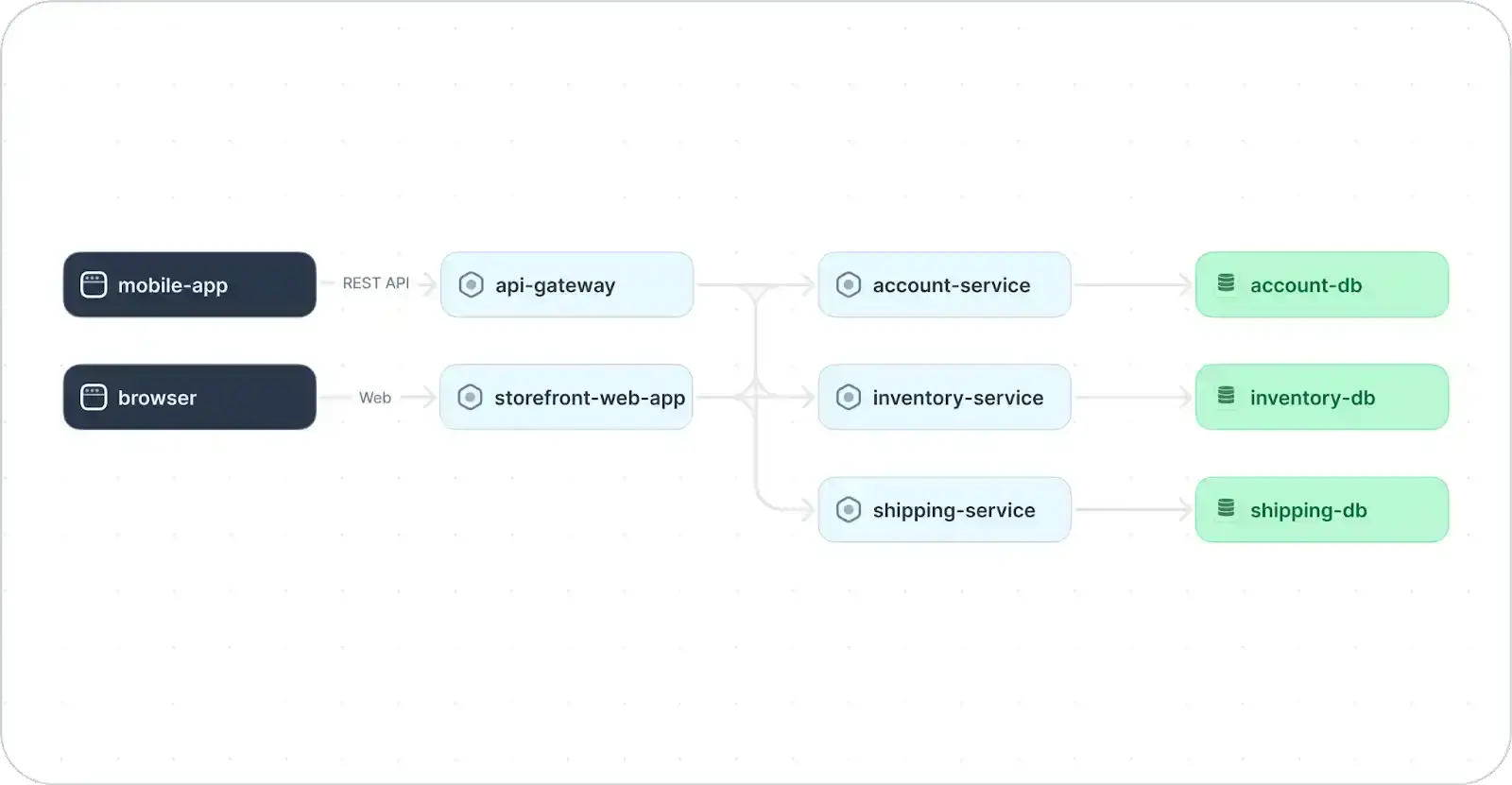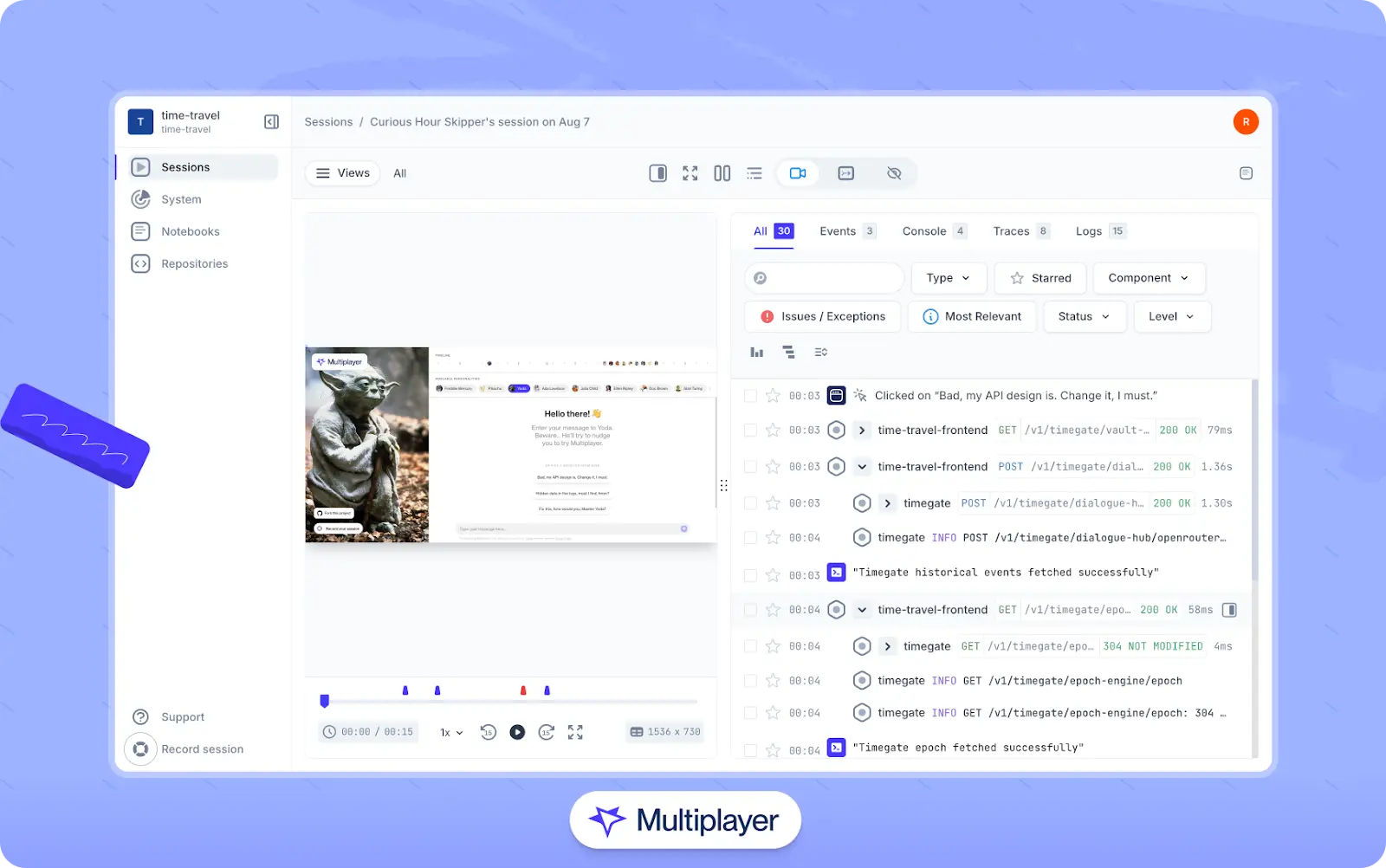Guide
Backend Architecture: Tutorial & Best Practices
Table of Contents
Backend architecture encompasses all system components, infrastructure, and processes that are not visible to end users. This includes elements such as servers, databases, APIs, third-party integrations, business logic, caching solutions, message brokers, a security layer, and more.
Well-designed backend architectures should be capable of handling a variety of scenarios, such as unexpected user traffic patterns, complex data management, and security concerns. Conversely, poorly designed backend architectures can lead to an increased risk of downtime, a lack of application maintainability or scalability, and security vulnerabilities.
There are many approaches to backend architecture design, and the best method for a system varies based on the nature of the system and the application’s intended purpose. In this article, we discuss common backend components, design patterns, and best practices for designing resilient, secure, and scalable backend architectures. In doing so, we hope to empower your team to make better-informed architecture decisions for your application.
Summary of key backend architecture concepts
The table below provides an overview of important backend architecture concepts. In the following sections, we discuss each concept in greater detail.
| Concept | Description |
|---|---|
| What is backend architecture? | Backend architecture encompasses all server-side components of a software application. It is typically responsible for processes like authentication, authorization, data processing, and third-party API integrations. |
| Backend architecture components | Common backend components include servers, databases, APIs, and authentication and authorization systems. More complex distributed systems frequently utilize message queues, caching solutions, and orchestration solutions. |
| Modern backend development and phases | Backend development is a complex and iterative process. While earlier approaches to backend design involved designing the entire system architecture up front, modern practices should encourage an iterative approach to architecture design, a shared understanding of backend architecture, and comprehensive documentation. |
| Backend architecture best practices | Best practices for backend architecture design include employing system design patterns, designing for modularity, and making architecture a collaborative effort. |
What is backend architecture?
Backend architecture refers to the conceptual design and structure of server-side components, including business logic, databases, security layers, and infrastructure where processes like authentication, data management, and third-party integrations take place. Designing a backend architecture is a complex, high-level task that typically involves deciding on and documenting a blueprint for the system. This blueprint is then referenced by the development team as they build the backend system.
Backend architecture components
Backend architectures consist of various hardware and software components that work together to achieve common goals. The table below provides an overview of common backend architecture components and their implementations.
| Component | Description | Implementation |
|---|---|---|
| Server | Provides resources, data, and services to clients. Servers house important business logic, process and reply to requests sent over a network, and manage data. | Provision hardware resources (on-premises, through a cloud provider, or hybrid), utilize appropriate software and frameworks, and write server-side code. |
| Database | Manages, retrieves, and stores data. Relational (SQL) databases organize data via tables with predefined schemas, while nonrelational (NoSQL) databases provide more flexible schemas. | Typically implemented via a database service, which provides both data management and a database server for queries. Examples include MySQL, MongoDB, and PostgreSQL. |
| Caching solution | Temporarily stores data in a fast-access storage layer. Caching solutions improve performance by keeping frequently requested resources readily available to end users. | Can be implemented using web browsers’ local storage, CDNs (e.g., Cloudflare Cache, Amazon Cloudfront), in-memory (RAM) caches (e.g., Redis), or within application code. |
| API | Facilitates communication among components, systems, and applications through a set of rules and protocols. APIs specify methods, URIs and URLs, and data formats that applications can use to request and receive data. | Configure servers and databases to respond to client requests according to an API protocol such as REST, SOAP, RPC, or GraphQL. |
| Asynchronous messaging | Enables decoupled, asynchronous communication between services for better performance, scalability, and reliability, typically within serverless or microservices architectures. | Select a messaging pattern (e.g., publish/subscribe, queue-based, request/reply) according to your use case, then choose an appropriate message broker (e.g., Kafka, RabbitMQ). |
| Authentication and authorization | Authentication verifies a client or user's identity, and authorization determines whether the client or user has the necessary permissions to access a resource or perform an action. | Implemented via various authentication methods (e.g., password-based, multi-factor authentication, OAuth) and by writing application code to enforce authorization policies (e.g., role-based access control, policy-based access control, etc.). |
Other backend components include load balancers, containerization services (such as Docker), orchestration systems (such as Kubernetes), third-party integrations, logging and monitoring solutions, and service discovery. It is important to note that backend architectures vary widely with the nature of the application and its functional and non-functional requirements.
Full-stack session recording
Learn moreModern backend development and phases
Backend architecture design
In the waterfall era of software development, many teams employed a backend architecture design approach known as big design up front (BDUF). The BDUF approach specifies that considerable time should be invested in upfront design so that an application’s backend architecture design is largely completed and perfected before writing code.
However, with the rise of agile software development and more rapid, iterative release cycles, many teams have adopted correspondingly iterative approaches to backend architecture design. These include:
- Rough design up front (RDUF): Designing only significant parts of a system up front
- Sufficient design: Ensuring high-quality designs for business-critical aspects of a system while investing less time in designs for other components or subsystems
- “Good enough” architecture: Determining how much time to spend designing system architecture based on how it will impact development efforts
A common thread among these approaches is that they each combine some degree of upfront planning with the principles of evolutionary architecture. They allow a system to evolve over time, adapting to changing requirements, technologies, and business priorities without requiring costly overhauls of the system’s architecture. In this paradigm, backend development is an evolutionary process; the design evolves as the application progresses.
Backend architecture development
After the core architectural decisions are made, the development team prepares the environments and provisions the required resources. This involves implementing the chosen technologies and frameworks, setting up development workflows and CI/CD pipelines, securing the system, and configuring infrastructure as code (IaC).
As the team develops the components and services defined during the initial planning stages, it is important to continue revisiting the backend architecture and evaluating whether its current design aligns with business goals and the application’s evolving functional and non-functional requirements. To this end, shared knowledge of the backend architecture is highly beneficial, as it empowers all team members—not just senior developers, architects, or team leads—to understand the underlying system design and contribute to the application in meaningful ways.
The role of documentation
To facilitate knowledge sharing, it is crucial to document each iteration of the system’s design, highlighting key tradeoffs and making note of important architectural decisions for current and future team members. This should be done during the design phase and throughout the software development lifecycle.
A key step in the documentation process is crafting effective architecture diagrams with varying levels of abstraction for different audiences. For example, developers may benefit from diagrams with detailed information on interfaces, implementation, and component relationships, while business executives may require a more high-level overview of the application architecture.

Example of a system architecture diagram for a microservices architecture (adapted from source).
Interact with full-stack session recordings to appreciate how they can help with debugging
EXPLORE THE SANDBOX(NO FORMS)
While creating and maintaining architecture diagrams can be time-consuming, tools like Multiplayer significantly streamline this process. Multiplayer automatically generates architecture diagrams based on source code and automatically discovers, tracks, and detects drift in system architecture. The tool also supports other forms of documentation that are more sophisticated and dynamic than traditional static docs. For example, notebooks allow teams to document integrations and design decisions using executable code and API blocks, and full-stack session recordings capture how frontend actions correlate with backend behavior. Together, these features provide a full picture of the system and help developers trace issues, debug complex systems, and build more reliable software.
Backend architecture best practices
Backend architecture is a broad topic with many considerations. The scope and nature of backend systems vary widely across different use cases, and successful procedures for designing and implementing backend architectures vary with the application itself, the size and composition of the development team, and time and budgetary constraints.
That being said, following established best practices can greatly contribute to the implementation of an effective backend architecture, regardless of the size and nature of the project. In the remaining sections, we present four best practices that apply across a broad range of scenarios.
Employ system design patterns
Designing backend architectures presents many challenges, from ensuring scalability and reliability to facilitating effective communication and data management across numerous components and services. Because many businesses face similar challenges when designing distributed backend systems, a number of distributed system design patterns have emerged to address common issues. Seven of these patterns are summarized in the table below.
| Design pattern | Description |
|---|---|
| Ambassador | A proxy service (the ambassador) handles common tasks—such as logging, monitoring, and routing—that are needed by all services within the system. Rather than repeatedly implementing this functionality within each service, all services make calls to the ambassador to perform these tasks. |
| Circuit breaker | A circuit breaker component detects failed requests to one or more services and prevents failures from cascading throughout the system. When the circuit breaker detects failed requests beyond a predefined threshold, the circuit breaker blocks those requests for a predetermined period (open-circuit state), sends a few test requests to the failed service after a timeout period (half-open state), and reopens the connection only after test requests are successful (closed-circuit state). |
| Command query responsibility segregation (CQRS) | Read (query) and write (command) operations are decoupled into separate services, allowing each service to be optimized independently. This pattern facilitates better scalability and efficiency in systems with significantly different read and write characteristics, such as social media platforms or ecommerce websites. |
| Event sourcing | Rather than repeatedly writing data to a single record, changes to data are stored as incremental events over time. This allows the system to maintain a comprehensive version history and recreate the state of the data record at any point in time. |
| Leader election | Identical nodes in a system select a leader from among themselves to coordinate tasks between nodes without conflicts. Since all nodes are otherwise identical, a new leader can be elected if the current leader experiences a failure or goes offline. |
| Publisher/subscriber | Services that produce events (publishers) are decoupled from services that consume them (subscribers). Publishers push events to an event bus, a central hub that broadcasts events to subscribers. This pattern allows publishers and subscribers to communicate without direct awareness of each other, meaning that components can be added or removed without affecting communication. |
| Sharding | Data from a single database or table is divided into smaller subsets (shards) that can be stored on separate nodes. This pattern is used to improve query performance or implement fault tolerance and redundancy for stored data. |
Depending on the use case, different system design patterns can be combined with one another to solve architecture problems. Appropriate patterns should be carefully chosen during the initial architecture planning stages to speed up development and improve system reliability, scalability, and maintainability.
Utilize a CI/CD pipeline
CI/CD pipelines allow developers to quickly iterate through features and test their implementation live on test environments. They offer immediate feedback and allow code to be tested, integrated, and deployed with minimal manual intervention, leading to faster development and shorter release cycles.
However, implementing CI/CD effectively comes with a number of challenges. For example, effective CI/CD hinges on reliable testing practices and test automation. Consider the following best practices:
- Keep test scripts up to date: Update test scripts along with application code to avoid false passes or fails in test results.
- Regularly maintain test suites: Manage the scope and number of automated tests to keep test suites lightweight. Bloated or badly maintained test suites can take a great deal of time and resources to run, undermining CI/CD’s promise of fast and reliable delivery.
- Choose a suitable testing environment: Ensure that your team has access to testing environments that are isolated and representative of the production environment to facilitate fast execution and accurate results.
One click. Full-stack visibility. All the data you need correlated in one session
RECORD A SESSION FOR FREEAnother challenge when implementing CI/CD is ensuring environment parity and clean environments for staging, testing, and production. Use tools like containerization and IaC to provision and retire resources quickly. This allows the development team to spin up consistent environments when needed to facilitate development or quality assurance efforts.
Finally, effective CI/CD relies on continuous iteration and improvement. Analyze metrics such as the number of builds triggered in a given timeframe, the speed of deployments over time, and statistics from automated tests. Tracking these metrics allows for data-driven analysis of existing CI/CD practices and provides insights into areas for improvement.
Design for modularity
In a modular backend architecture, a system contains separate, interchangeable components or modules, each responsible for a specific functionality. Modules should be loosely coupled from one another, meaning that each module is its own independent unit and has only minimal dependencies on other modules when performing its role within the system.
There are many ways to implement modularity within an application or distributed system. A few common techniques are listed below:
- Adopt a modular architecture style: System architecture styles dictate how components interact with one another. Modularity is a primary concern in styles like microservices and event-driven architectures, where components are loosely coupled and isolated for better scalability, flexibility, and fault tolerance.
- Utilize an API gateway: An API gateway acts as a single entry point for an application or system. It sits between the client and the application’s backend system, receives all client requests, and routes them to the correct backend component or service. This allows the backend architecture to be updated and new components to be added without affecting the client interface.
- Organize code using modules and libraries: At the implementation level, modularity is achieved by developing well-organized code libraries or utilizing third-party packages, such as through NPM or pip. Each module encapsulates a specific functionality that can be shared and reused across different system components.
It is important to define distinct boundaries between modules and ensure that each module has a clear and consistent interface. Break application requirements down into distinct logical units, decide which pieces of functionality can be isolated into separate components or services, and design inter-component communication so that it can remain consistent while accommodating new features.
Use full-stack session recordings to understand system behavior
Debugging and feature development hinge on an accurate understanding of how your system actually behaves in production. In distributed architectures, this is rarely straightforward: requests may traverse dozens of services, asynchronous queues, caches, and databases before returning a result. Failures or performance regressions often surface far from their root cause, and logs or metrics from individual components rarely provide a complete picture. These same issues make feature development difficult, since introducing new functionality often requires determining how changes may impact multiple services and dependencies.
One way to address these challenges is by using full-stack session recordings to capture end-to-end system behavior, from user interactions to the backend calls and infrastructure activity they trigger. Tools like Multiplayer allow you to annotate recordings with sketches, comments, and requirements to turn them into living blueprints for debugging issues or planning new features.

Multiplayer’s full-stack session recordings
Recordings can also be shared across the team or provided as input to AI coding assistants to provide context that code alone does not. AI tools can then generate more accurate suggestions on how to fix bugs, implement new features, or adapt architecture to evolving system requirements.
Stop coaxing your copilot. Feed it correlated session data that’s enriched and AI-ready.
START FOR FREEConclusion
Backend architecture is the conceptual design of various components, services, and functionalities that process user requests, manage data, and perform core business functions. When designing and developing backend systems, teams should strike a balance between upfront planning and iterative design, employ system design patterns, and ensure that architectural knowledge is well-documented and shared across the development team. In doing so, engineers can design and implement performant, maintainable backend systems to meet the needs of modern users and evolving business requirements.


